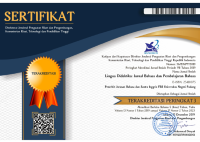Analysis of the Meaning of Pragmatics of Fatisanity in Class Discussions
 ), Dedi Richi Rizaldy(2), Isyaau Akhsanil Khakim(3),
), Dedi Richi Rizaldy(2), Isyaau Akhsanil Khakim(3), (1) Universitas PGRI Madiun
(2) Universitas PGRI Madiun
(3) Universitas PGRI Madiun
 Corresponding Author
Corresponding Author
Copyright (c) 2021 Lingua Didaktika: Jurnal Bahasa dan Pembelajaran Bahasa
DOI : https://doi.org/10.24036/ld.v15i2.111033
Full Text:
 Language : id
Language : id
Abstract
This research aims to obtain the meaning and the appearance of phatic in a class discussion. This research used the descriptive qualitative method. The data collection methods were in the forms of listening and speaking. The data collection techniques used writing and recording. The obtained data were analyzed using the padan method. The data analysis consisted of data reduction, data display, and verification. Based on the results of the research, there were four appearances and the meanings of phatic pragmatics in the discussion. The meanings of phatic pragmatics consisted of a) the phatic pragmatic meant an acceptance, b) the phatic pragmatic meant the inviting, c) the pragmatic meant a refusal d) the pragmatic meant gratitude. There were four purposes of phatic pragmatics, namely, 1) to respect others, 2) to take care of other people’s feelings, 3) to enhance cooperation, and 4) to improve humor.
Keywords
References
Anwar, A. (1984). Strategi Komunikasi. Bandung: Armico.
Arbai, A. M. dan A. (2018). Metode Diskusi dan Tanya Jawab dalam Pembelajaran SKI untuk Meningkatkan Keaktifan Belajar Siswa Kelas VII- H MTS Al Mahrusiyah Lirboyo Kediri. Jurnal Pendidikan Dan Studi Keislaman, 8(3), 451–466.
Arta, I. M. R. (2016). Prinsip Kerja Sama dan Kesantunan Pada Pembelajaran Bahasa Indonesia dengan Pendekatan Saintifik. Jurnal Studi Keislaman Dan Ilmu Pendidikan, 4(2), 139–151.
Damarsasi, G. D. (2017). Kajian Sosiopragmatik Kefatisan Berbahasa Para Abdi Dalem Keraton Yogyakarta. Universitas Sanata Dharma.
Djajasudarma, T. fatima. (2006). Metode Linguistik Ancangan Metode Penlitian dan kajian. Bandung: PT. Eresco.
H.P. Grice. (1975). Logic and Conversation In Cole P (ed). New York Academic Press, 3, 41–53.
Rahardi, R. K. (2016). Manifestasi Wujud Dan Makna Pragmatik Kefatisan Berbahasa Dalam Ranah Pendidikan. Adabiyyāt: Jurnal Bahasa Dan Sastra, 15(2), 226..https://doi.org/10.14421/ajbs.2016.15206
Rohmadi, M. (2014). Kajian Pragmatik Percakapan Guru Dan Siswa Dalam Pembelajaran Bahasa Indonesia. Jurnal Paedagogia, Fakultas Keguruan Dan Ilmu Pendidikan Universitas Sebelas Maret, 17(1), 53–61.
Rosita, F. Y. (2017). Ekspresi Penerimaan Dalam Dialog Antarpenghuni Kos (Kajian Pragmatik). KEMBARA: Jurnal Keilmuan Bahasa, Sastra, Dan Pengajarannya, 2(1), 23–30. Retrieved from http://ejournal.umm.ac.id/index.php/kembara/article/view/4040
Sudaryanto. (2015). Metode dan Aneka Teknik Analisis Bahasa: Pengantar Penelitian Wahana Kebudayaan Secara Linguistik. Yogyakarta: Andi Press.
Wijana, I. D. P. (1996). Dasar-Dasar Pragmatik. Yogyakarta: Andi Press.
Yule, G. (2006). Pragmatik. Yogyakarta: Pustaka Pelajar.
 Article Metrics
Article Metrics
 Abstract Views : 394 times
Abstract Views : 394 times
 PDF Downloaded : 131 times
PDF Downloaded : 131 times
Refbacks
- There are currently no refbacks.
Copyright (c) 2021 Lingua Didaktika: Jurnal Bahasa dan Pembelajaran Bahasa

This work is licensed under a Creative Commons Attribution-NonCommercial 4.0 International License.









